I caught Sam Raimi’s SPIDER-MAN on TV the other night, and enjoyed once more the way Willem DaFoe and James Franco perfectly captured the fractured relationship between Norman Osborn (secretly Spider-Man’s arch-enemy the Green Goblin) and his son Harry, Peter Parker’s best friend and roommate.
I was recently inspired to go back and take a closer look at poor Harry, particularly his final appearances in the pages of SPECTACULAR SPIDER-MAN in 1991 through 1993, courtesy of writer J. Marc DeMatteis and artist Sal Buscema. But first, let’s go back to the beginning, shall we?
Harry Osborn made his first appearance in AMAZING SPIDER-MAN #31 (December 1965), introduced along with Gwen Stacy as new classmates of Peter Parker’s on his first day at Empire State University.
Early on, Harry sided with Flash Thompson in picking on and looking down on Pete, with Peter’s continual state of distractedness due to his aunt’s ailing health and his career as Spider-Man being mistaken for snobbishness. Harry also had something of an inferiority complex early on, a precursor for much bigger emotional problems to come. Harry also had some problems with his father, which also led to the ice breaking between he and Pete.
Eventually, Pete and Harry got to be best friends, the two often double-dating with Gwen Stacy and Mary Jane Watson. The two also became roommates, a relationship that had its ups and downs. Harry’s several bad experiences with drugs didn’t help his already fragile mental state.
Harry’s breakup with Mary Jane came at the same time, all of which led to a full-on nervous breakdown. The nervous breakdown came at just the same time that Peter’s battles with Harry’s father were reaching their height, with the murder of Gwen by the Goblin. In the aftermath, Pete faces a decision: stay to help his friend, or go after the man who killed the girl he loved:
After Harry recovered from the drug trip, he blamed Spider-Man for the death of his father (as Osborn’s career as the Goblin wasn’t publicly known, thanks to Harry removing the costume from Norman’s corpse before the police arrived), while harboring ill will toward Mary Jane for dumping him and spending more time with Peter.
Harry’s friendship with Peter seemed to be a thing of the past as well. Harry’s mania quickly sank into dementia, made worse when he discovered a certain secret his roommate had been keeping.
Finally, Harry’s slide into insanity came to a head in AMAZING SPIDER-MAN #136 (September 1974), “The Green Goblin Lives Again!”, in which a now full-on raving bonkers Harry takes on his father’s mantle as the Goblin, a fact Spidey discovers when his apartment is firebombed, demolishing the place and nearly killing Mary Jane.
Staking out Norman Osborn’s abandoned warehouse lair, Spidey is soon attacked by the Goblin and finds his worst fears realized, as he’s forced to fight his best friend, who knows Spidey’s greatest secret and could destroy his life in an instant.
Harry, while a beginner at this supervillain business, takes to it fast, and soon approaches Spidey with a fiendish dilemma: Aunt May, Mary Jane and Flash Thompson have all been kidnapped, but only one has a real bomb precariously perched over their head. Unfortunately for Harry, while he has his father’s costume and weapons, he doesn’t have Norman’s chemically induced strength, and an enraged Spidey lets him know, the hard way:
Thanks to his spider-sense and a bit of luck, Spidey gets to Aunt May before the bomb above her head goes off, then heads back to Norman’s townhouse to figure out what to do with Harry. The two scuffle once more, and Harry is slammed into a circuit breaker, with the shock knocking him out. Not knowing what else to do, and determined that Harry receive the psychological help he needs, Spidey destroys the Goblin costume, changes back into Peter Parker and waits for the police, who take the now clearly disturbed Harry into custody. Pete waits for the worst, as Harry exposes his identity as Spider-Man to the police, who aren’t necessarily convinced:
Harry was eventually committed, and returned to sanity with the help of a good psychiatrist, Dr. Bart Hamilton, who in turn used the information he gleaned from Harry during their hypnosis sessions to find another hidden cache of Norman’s equipment and briefly become the third Green Goblin. Hamilton’s career was pretty brief, and the only reason he even lasted a second against Spider-Man was that Spidey was convinced it was Harry under the mask and was pulling his punches. Harry meanwhile, had developed a sort of selective amnesia (perhaps from the hypnosis sessions with Hamilton), and retained no knowledge either of his father’s career as the Green Goblin (or his own) or of Peter Parker’s secret. Seemingly fully recovered, Harry met and fell in love with, of all people, Liz Allan, Peter Parker’s high school friend and sometimes love interest. After graduating college, Harry took over Oscorp, his father’s company, and Harry and Liz got married and had a child, named after Harry’s father, and moved to Long Island, no longer a part of Peter’s day-to-day circle of friends.
Harry and Liz returned to the scene a few years later, after a new Goblin character, the Hobgoblin, appeared and began threatening the Osborns, a situation Spider-Man found himself drawn into. Moving back into the city, Harry was able to do his old friends Peter and Mary Jane (now married) a favor, renting them an apartment in the building he owned and where he and his family lived, after Peter and MJ were evicted from their place following an ugly incident with a millionaire who was stalking Mary Jane. So here we are, with Peter and Mary Jane living just a floor below what for all intents and purposes seems to be a healthy, stable Harry Osborn and his family. Which is where we pick things up in SPECTACULAR SPIDER-MAN #178 (July 1991), by DeMatteis and Buscema.
We first see Harry beginning to lose his grip in the first chapter of the 6-part “The Child Within,” in which Harry’s resurfacing father issues are juxtaposed with revelations about the origin of the cannibal supervillain Vermin, captured by Spider-Man and handed over to psychoanalyst Ashley Kafka foe treatment. As we learn how Vermin’s later atrocities were framed by abuse, we see Harry beginning to succumb to his own ghosts, as he begins to hear the voice of his father in his head while he spends time with his own son, little Normie.
(It’s good to see, by the way, that Normie seems to have avoided the other Osborn family curse, that odd corduroy hairstyle that both Norman and Harry sport.)
As the tale progresses, Harry’s hallucinations about his father grow more and more vivid, and begin to involve Spider-Man as well. Along with the hallucinations return more of Harry’s suppressed memories, particularly that most dangerous piece of information: the fact that his best friend Peter is Spider-Man, the man he still blames for killing his father. Soon Harry’s visions involve both Norman and Peter, as an increasingly lost Harry is caught between them.
In the end, it’s too much for Harry to fight, and he solemnly says goodbye to his family, before the inevitable comes. Next thing, Harry is back in the Goblin gear and headed after Spidey, and he remembers everything.
Spidey and the Goblin fight, with Peter once more at a disadvantage, not wanting to hurt his friend.
Harry is able to get Spidey down for the count with a gas attack, and after the two friends share a moment and Harry struggles with his identity…
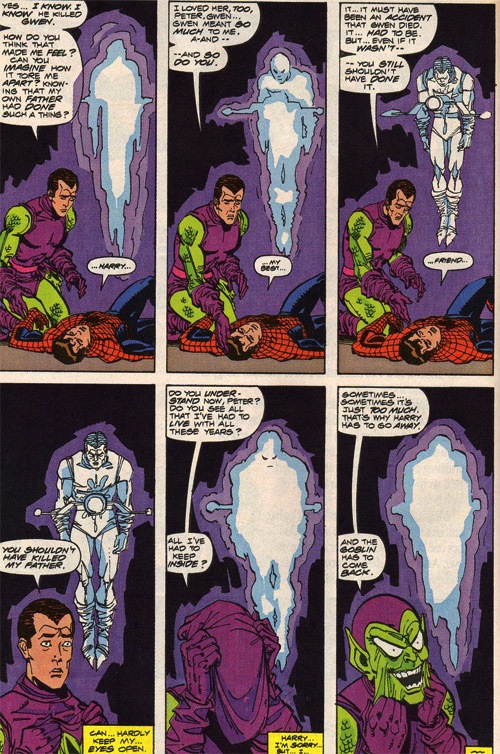
…Harry nails Spidey with one of his father’s hallucinogenic pumpkin bombs, setting Spidey off on an acid trip through his own childhood abandonment issues, resulting in a raving mad Spider-Man tearing up the joint, and knocking out Harry as well.
I’ll be honest. Usually, if someone tries to blend a lot of psychological child-abuse elements into a comic-book superhero story, I have very little patience with it. It almost always comes out shallow and preachy, and doesn’t really ring true. However, the themes do resonate well with these characters, since their pasts are so well established. Yes, naturally Peter Parker would have some abandonment issues, with his parents dying so young. And longtime AMAZING SPIDER-MAN readers saw first-hand the abusive relationship between the domineering, neglectful Norman Osborn and his son Harry. So here it works, especially under the light touch of writer J. Marc DeMatteis, who often injects a lot of psychological and touchy-feely themes in his work, with, for me anyway, mixed success. Here, though, DeMatteis hits the tone just right, cleverly contrasting the damaged childhoods of Peter, Harry and Vermin without dwelling overmuch on the details of the abuse or giving in to the overuse of psychobabble.
And while we’re talking creators, let’s hear it for Sal Buscema. Perennially overlooked among talk of the great Spidey artists, Sal put together an extremely reliable, satisfying, well-told run here on SPECTACULAR SPIDER-MAN in the ’90s, delivering handsomely rendered, communicative storytelling, (both pencils and inks, by the way — no small feat) with a creepy, moody style that meshed well with DeMatteis’ more emotional, psychological story arcs. Buscema particularly shined whenever the Goblin appeared, combining the elongated face and angles from the Ditko version with the wide, expressive eyes from John Romita’s Goblin, giving Harry’s Goblin a unique visage all his own.
As “The Child Within” ended, Peter and Harry are locked in battle once more, until Peter decides he’s just had enough, and refuses to fight his friend any longer:
Harry swoops in for the kill, but finds he can’t bring himself to do it:
Peter extends a hand of friendship, but Harry swats it away, still unable to make the leap back to the man he was. The Goblin leaves, but with a word of caution:
In the story’s heartbreaking epilogue, we see Harry return for a last moment with his family, before leaving once more to figure out his next move. This was the genius of DeMatteis and Buscema’s Green Goblin: as much as he was the bad guy, you were never able to really hate him.
As the months passed, Spidey never stopped searching for his missing friend, but with no luck. Unfortunately, Harry hadn’t been idle over the ensuing months, discovering his father’s Goblin formula, and subjecting himself to a new, experimental version of the treatment Norman Osborn underwent, granting him superhuman strength, and it seems, furthering his mental instability.
Harry made his big return in “The Osborn Legacy” in SPECTACULAR SPIDER-MAN #189 (June 1992), not coincidentally the month of Spider-Man’s 30th anniversary. Harry makes his return known not only through playing some psychological mind games with Peter, dropping off a Goblin-in-the-Box with Aunt May and leaving an exploding Spider-man dummy in Peter and MJ’s bed, but also through kidnapping his family for a twisted Osborn family reunion, as his wife Liz, son Normie and brother-in-law Mark “the Molten Man” Raxton are forced to sit down to a formal dinner with the now clearly insane Harry, who’s taken to continually wearing his costume as a point of family pride.
Harry explains to his family that Norman’s mistake was neglecting his family, not his career as the Goblin, a mistake that Harry doesn’t intend to repeat.
Thanks to a spider-tracer planted on Raxton, Spidey tracks down Harry and family, but with Liz and Normie in the room, is hesitant to make any sudden moves toward Harry. In a powerful nod to the death of the original Goblin, Harry gets the drop on Spider-Man with his glider, but it doesn’t put Spider-Man out, and the two old friends clash once more, now evenly matched thanks to the Goblin formula.
Finally, Spidey has had enough, and kayos Harry, resigned to Harry telling the world his secret.
As Harry is led out by the cops, he screams to the collected onlookers, that he knows who Spider-Man is, and he’s going to tell the world–
Meanwhile, the aftereffects on the battle can be seen on little Normie’s face as he looks at Spider-Man:
Peter had a few quiet if uneasy months while Harry was locked up in the institution, while the police tried to pin his father’s crimes on him, with Peter just waiting for the day when Harry would reveal his secret. However, Peter suddenly had a lot more to worry about the day he came home to find a feverish Harry, freshly released for lack of evidence, sitting in Pete’s living room with his family.
It’s wonderfully subtle, both in the script and art, as the reader can’t tell if Harry is just toying with Peter and MJ or is genuinely happy to see them, at least at that moment. Later, while Peter freaks out and tries to find Harry, Harry kidnaps Mary Jane and takes her to that most overexposed piece of real estate in Spider-Man’s New York, the bridge where Gwen Stacy died. (Although, in their defense, this bit wasn’t quite so played out 25 years ago…) However, Harry’s not out to hurt MJ — he just wants to talk:
When Spidey returns home and sees Harry in his kitchen with MJ, he immediately attacks, but MJ intervenes, and Harry is soon on his way. In an attempt to drive Pete over the edge, Harry begins stalking Peter, just hovering behind him on the street while Pete’s in his civvies.
It’s really pretty creepy. When Pete confronts him, Harry lets him know what’s in store:
Next up, Harry heads to the Bugle (in full Goblin regalia), to let Jameson know about his newest project, the Norman Osborn Foundation, a charitable organization to do good works in his father’s name. However, later, an increasingly unhinged Harry, talking to his father’s portrait, lets slip the Foundation’s real purpose, to lure all of the city’s bigwigs and enemies of his father to the Osborn townhouse, which he’s got wired with explosives, to put Norman’s past to rest and “let the world know that there’s a new, even more ruthless Green Goblin in town.”
It all comes to a head in SPECTACULAR SPIDER-MAN #200 (May 1993), by DeMatteis and Buscema.
While Harry is working late at the Osborn townhouse with little Normie, MJ stops by for a last attempt to talk some sense into their old friend. It’s to no avail, especially once Spidey arrives, looking for Harry.
Harry tells MJ to leave, then quickly dons his costume and rushes out to engage in battle with Pete. Spidey and the Goblin engage in their fiercest, most violent battle ever, and wind up in a stalemate, thanks to Harry’s Goblin formula.
Unluckily for Spidey, the Goblin cheats, poisoning him with a chemical designed to shatter his equilibrium, rendering Spider-Man unable to even stand. Harry decides to end their battle, triggering the timer on the explosives on the townhouse, so they’ll both die. As Harry talks to Peter, his dementia momentarily snaps, and he realized that it won’t just be them to perish, that MJ and little Normie are still in the townhouse as well. Spider-Man, who’s still paralyzed, begs Harry to at least save their loved ones, and Harry comes through.
Outside, MJ is shocked to learn that Peter is still trapped.
Harry saves his friend’s life after all, then collapses, his body at last succumbing to the ravages of the Goblin formula.
Peter and Harry share a moment…
…and then he’s gone.
Emotional, at times even sentimental, tense, exciting and disturbing: this is how to properly put to rest a long-running character.
J. Marc DeMatteis and Sal Buscema provide not only a proper sendoff for one of Spider-Man’s old friends, but also a fitting and worthy follow-up to the death of Norman Osborn and Gwen Stacy some twenty years earlier. Sure, the easy way out would have been to make Harry a cardboard cutout of a villain, much like his resurrected father is portrayed nowadays. Instead, DeMatteis and Buscema dared to tell a real story, grounded in human emotion, one which has far more resonance than all the cheap stunt events of recent comics. Highly recommended.
As is often the way in comics, the impact of this story has been blunted by Harry’s resurrection in recent years, but it still holds up, in my humble opinion.
Unfortunately, these books aren’t collected, so you’ll need to do a little digging to put together the whole run, but I think you’ll find it’s worth the effort.

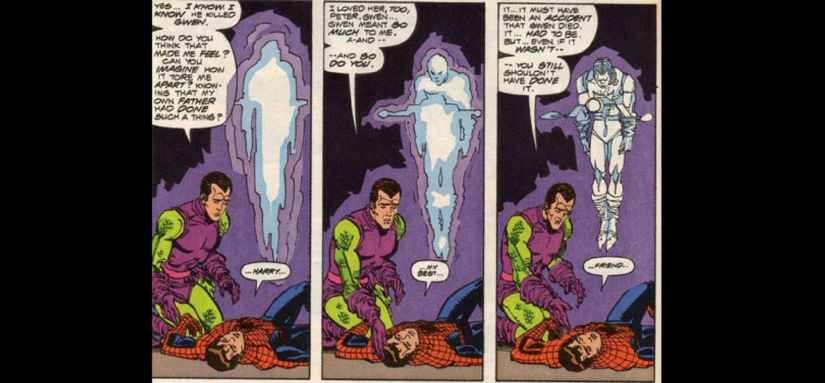


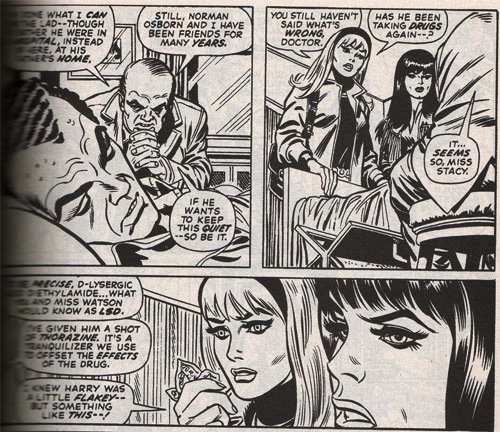
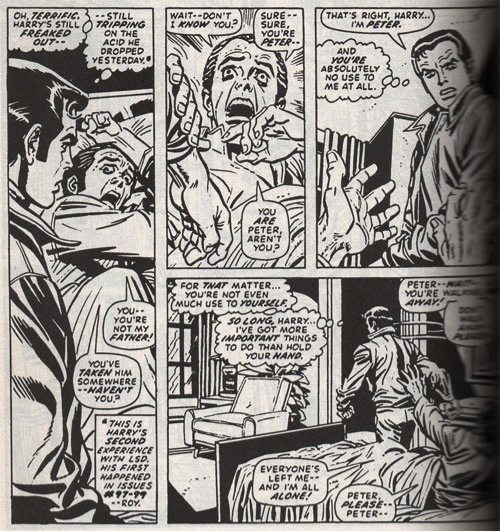




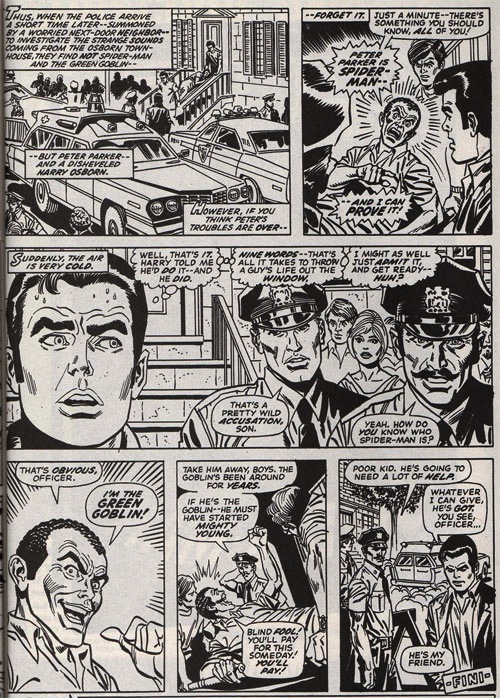



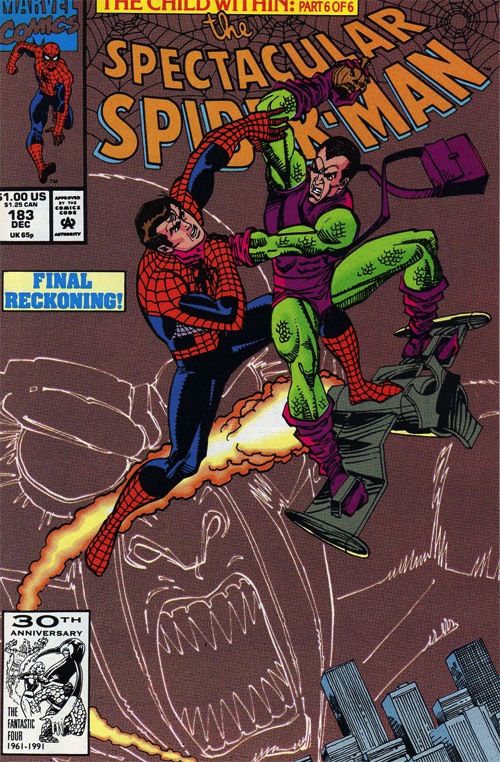


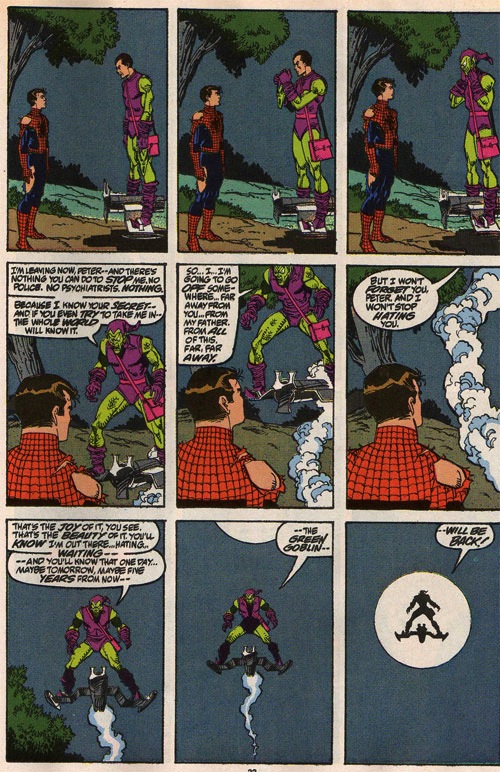
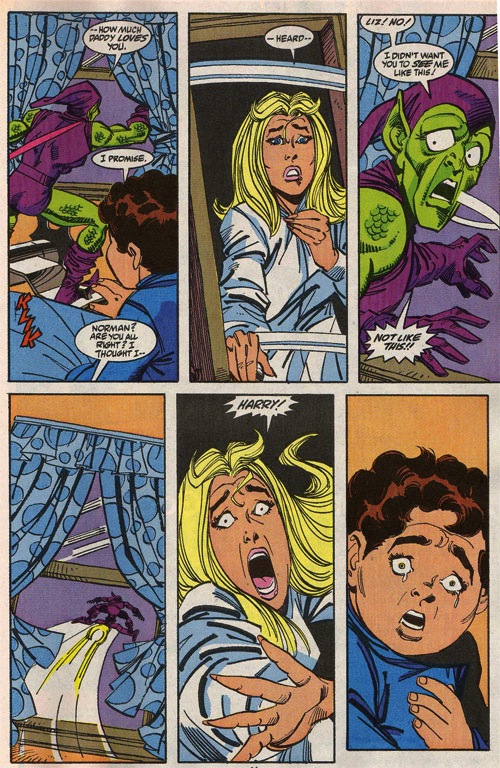



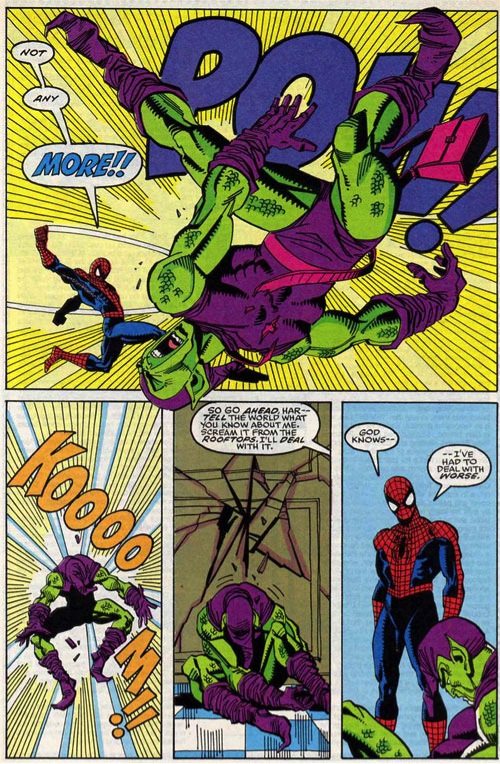
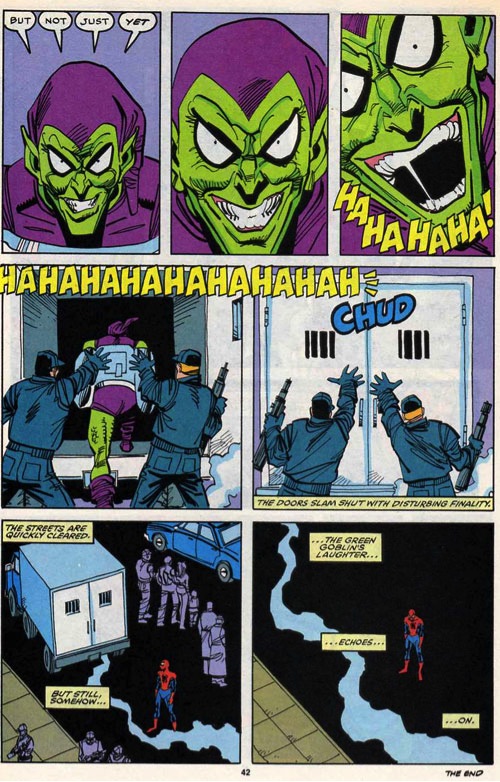

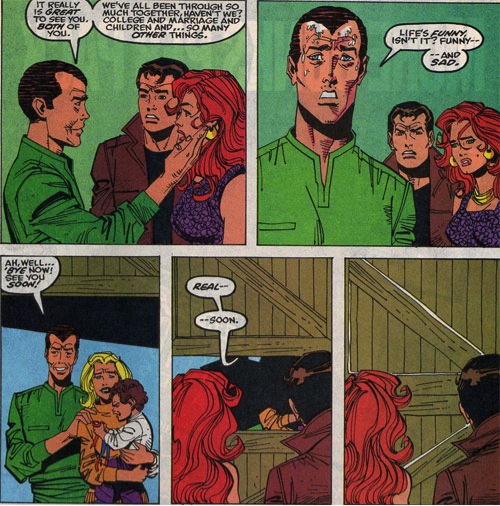
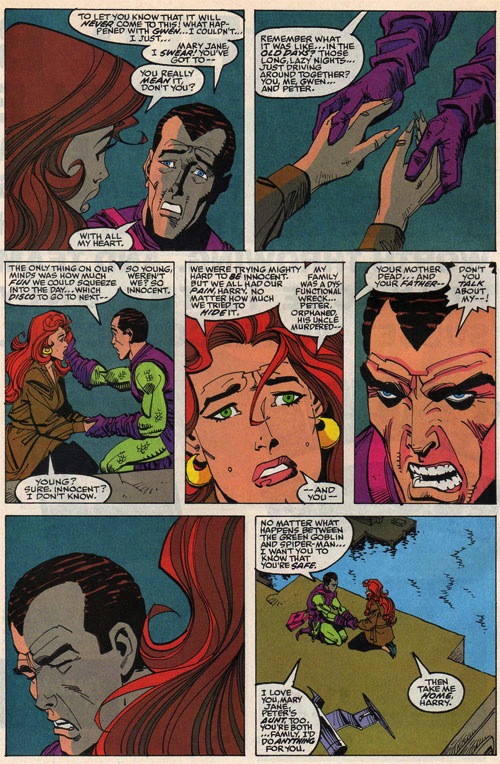

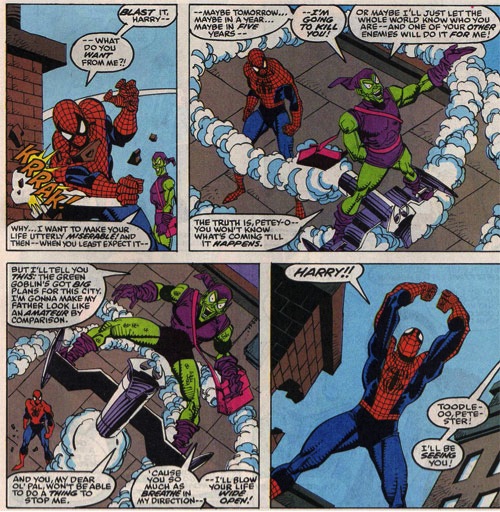
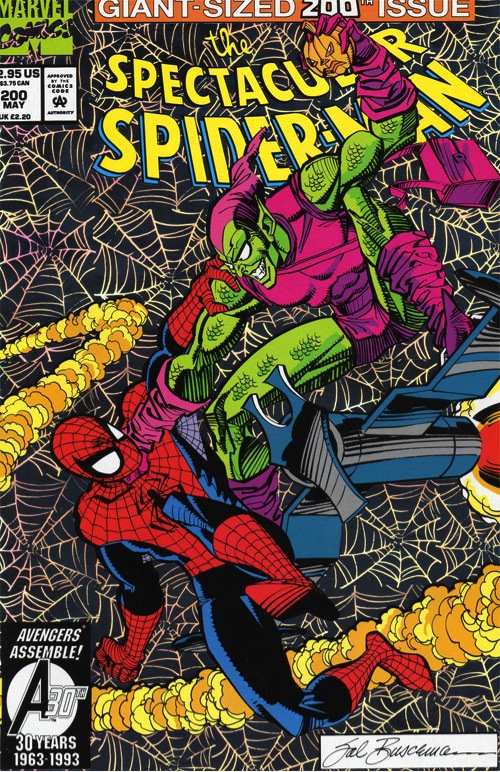

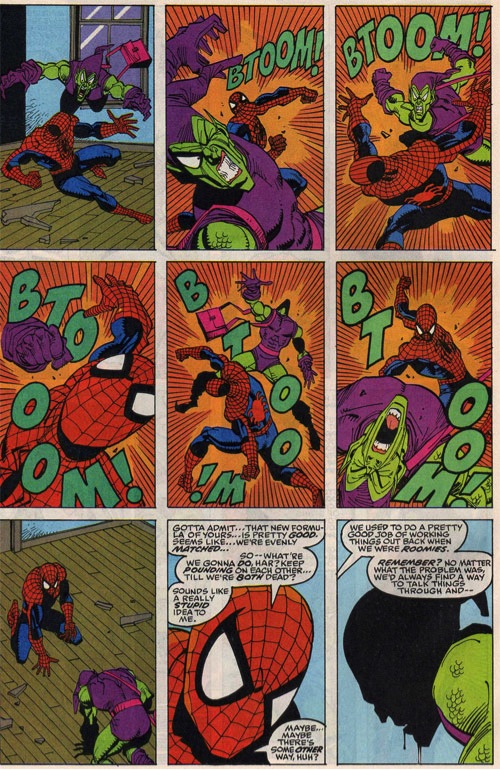


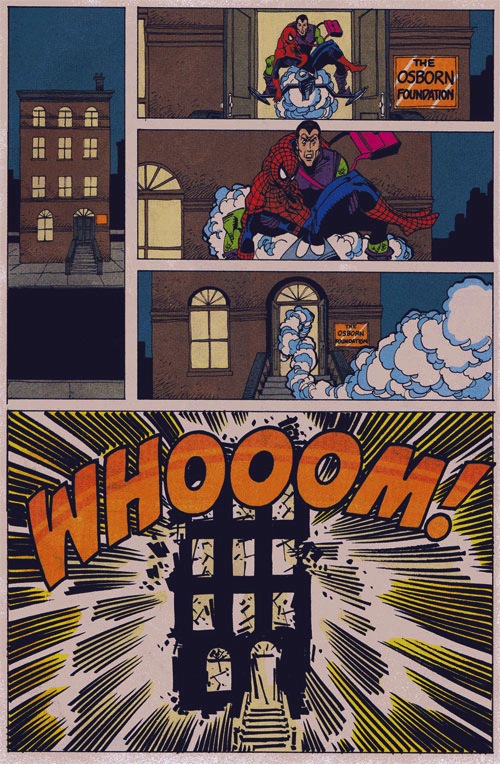
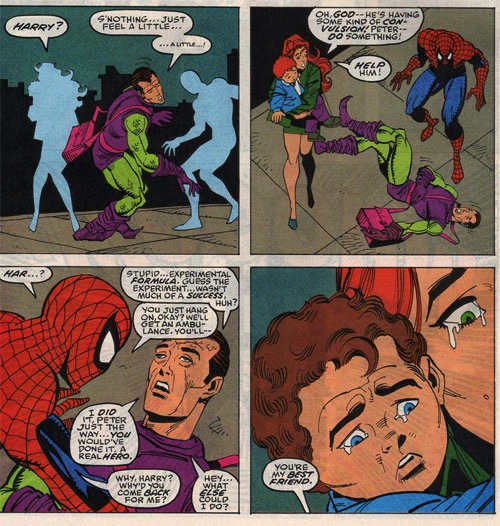
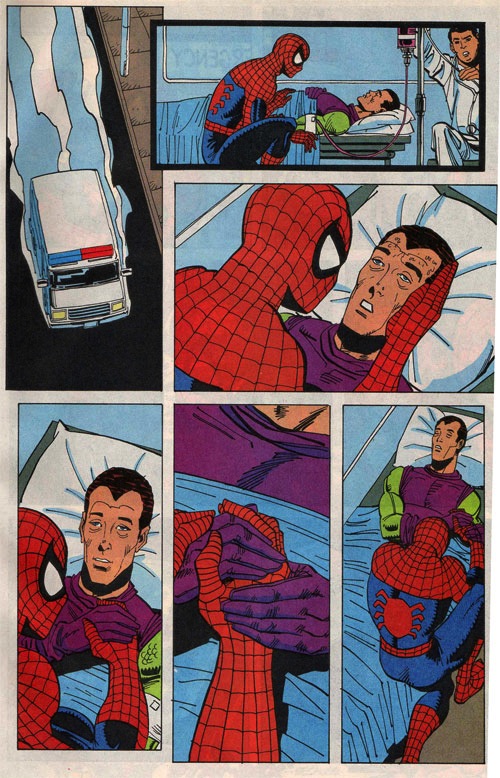

Comments are closed.